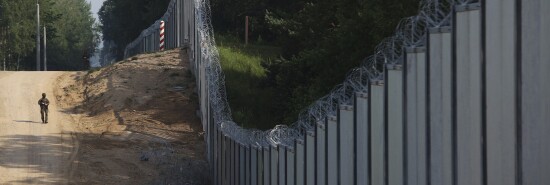
Poland becomes Russia’s scapegoat
Janusz Bugajski
Video Embed
A flurry of threats against Poland from Russian officials signals that the Kremlin increasingly views Warsaw as a major challenge to its imperial ambitions. President Vladimir Putin has accused Poland of pursuing territorial claims in the former Soviet Union and engaging in aggression against Russia. Such rhetoric disguises a deep-rooted fear that Poland is poised to overshadow Russian influence in Moscow’s former dominions, particularly in Ukraine and Belarus. The Kremlin also fears that Warsaw will become the key location for a U.S. military presence that will confirm Russia’s military as a second-rate force.
Since Russia’s full-scale invasion of Ukraine, Poland has been at the forefront of providing Ukraine with military aid, diplomatic support, and humanitarian assistance. Warsaw helped to mobilize international military supplies that enabled Ukraine to better defend itself against the Russian onslaught and regain its territories. In response to Moscow’s military aggression, Poland has committed itself to building up its military potential and challenging Russia’s regional predominance. Warsaw increased its defense spending from 2.4% of gross domestic product in 2022 to 3% in 2023 and is projected to reach over 4% in the coming years — the highest percentage of all NATO states. Warsaw plans to double the size of its army to 300,000 troops over the coming decade and thereby create a formidable deterrent against Russia’s aggression.
US MILITARY CAN’T IGNORE CHINA AND RUSSIA’S ALASKA FLOTILLA
The Kremlin has launched a three-pronged assault to counter Poland’s aspirations by deploying tactical nuclear weapons in Belarus, dispatching Wagner mercenaries close to the Polish border, and amplifying its military threats against Warsaw. Russia began to station tactical nuclear weapons in Belarus in June. The objective is to threaten both Ukraine and Poland with nuclear strikes against their troop formations and to dissuade any further Western military assistance to both countries.
After the June mutiny by Wagner mercenaries was defused in Russia, about 2,500 of them were relocated to Belarus. They have held exercises with Belarusian forces close to the Polish border, including the strategically important Suwalki corridor, which connects NATO members Poland and Lithuania and separates Belarus from the Russian-occupied territory of Kaliningrad on the Baltic Sea. Warsaw also reported that Belarusian military helicopters have violated Polish airspace. Polish officials believe that Wagner saboteurs are assisting Middle Eastern immigrants illegally crossing the Polish border and could themselves infiltrate the country posing as immigrants.
In response to these provocations, Poland has beefed up its military presence along the borders with Belarus and Kaliningrad. It has also recommended that Kaliningrad should be renamed Krolewiec and no longer use the name of a Soviet leader co-responsible for the mass murder of thousands of imprisoned Polish officers during World War II.
In an indication of increasing anger in Moscow, at the end of July Putin accused Poland of seeking to invade and annex parts of Belarus and Western Ukraine. His goal was to depict Belarusian President Alexander Lukashenko as the defender of Belarus’s sovereignty, despite his increasing subordination to Russia, and to drive wedges between Warsaw and Kyiv by portraying Poland as an expansionist power. In reality, Warsaw has no claims to pre-World War II territories that were seized by the Soviet Union, and it consistently supports the independence and integrity of all states that liberated themselves from Moscow.
Putin stated that any “aggression” against Belarus would directly involve the Russian Federation, which would “respond using all means at our disposal.” Despite its depleted capabilities due to massive military losses in Ukraine, Moscow has announced that it will build up its forces along its western border. Sergei Shoigu, Russia’s defense minister, charged Poland with being the main instrument of Washington’s “anti-Russian policy” and its “increasing militarization” with threatening the occupation of Russian territory. The fear of federal collapse is becoming more palpable in Moscow after the Wagner mutiny and growing dissent within the military over the failing war in Ukraine, and Poland is now the Kremlin’s primary scapegoat.
CLICK HERE TO READ MORE FROM THE WASHINGTON EXAMINER
Janusz Bugajski is a senior fellow at the Jamestown Foundation in Washington, D.C. His recent book is Failed State: A Guide to Russia’s Rupture. His forthcoming book is Pivotal Poland: Europe’s Rising Strategic Player.
